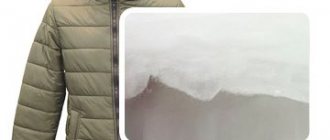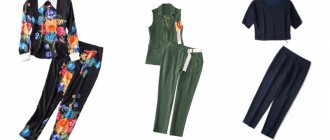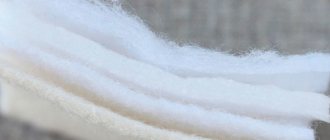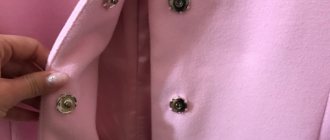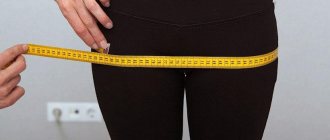A down jacket is a comfortable and practical winter or autumn outerwear that is not only comfortable for everyday wear, but also reliably protects from cold and bad weather on the frostiest days. We are used to purchasing down jackets in stores or leather and fur salons, but in the meantime you can easily sew one yourself. On the Internet you can find a huge number of videos and master classes that tell you how to sew a down jacket yourself. Patterns are also available in the public domain; using them you can easily sew your favorite product filled with padding polyester or down.
DIY down jacket
Required Tools
In order to sew a down jacket with your own hands, you will need to select high-quality fabric for the front side of the product. It is usually made of nylon, polyamide or polyester. All three materials perfectly retain their properties in conditions of strong wind and bad weather, have increased moisture resistance, do not wrinkle and perfectly retain their original appearance.
Nylon
When wearing a women's jacket in conditions of high humidity, it is worth choosing a material impregnated with special water-repellent compounds. This way the jacket will be truly reliable and comfortable. A distinctive feature of nylon is its light weight and increased water-repellent properties. Polyamide, in turn, allows the body to “breathe”.
In order to sew a women's down jacket, waterfowl down is often used as filling. It does not fall off, turning into lumps, reliably protects from the cold and does not add weight to a down jacket sewn by yourself. This is an excellent filler material that can be purchased at any store.
[do_widget_area sidebar5]
Down filler
However, experts at master classes on sewing women's down jackets advise paying attention to cheaper and more comfortable padding polyester. It will be very difficult for novice needlewomen to work with fluff, especially since it is quite expensive. Sintepon lacks some of the functional features of down, but at the same time retains heat well inside the down jacket and does not add extra weight to the product.
Sintepon
It is suggested to choose polyester as a lining at master classes. It does not wrinkle, allows air to pass through well, the body does not sweat when in contact with it, and the person feels quite comfortable.
To create a down jacket with your own hands you will need:
- sewing machine;
- overlock;
- tailor's scissors;
- tape measure;
- needles, pins;
- graph paper and pencil for creating a pattern;
- chalk.
Sewing tools
A similar set of tools can be found in the arsenal of any needlewoman who intends to sew a down jacket with her own hands. Most often, beginner seamstresses are offered options for sewing loose-fitting coats filled with padding polyester.
Choosing fabric for a coat
When sewing any product, it is very important to choose the right fabric. Naturally, in this case you should choose suitable materials. This can be soft cashmere, tweed or polar, or coarser fabrics such as bouclé or drape. The appearance of the fabric depends on the weave of the threads. It can be satin, twill, linen or a combination.
For winter, the best option would be thick cloth, which can be duplicated with a lining with insulation or an underlining can be made. For a demi-season option, cashmere with a thin lining is suitable. But for a very thin coat it is better to choose gabardine or diagonal.
When choosing a material, you need to consider what the pattern of the cocoon coat will be. Fabrics with plain weave, which can be classified as highly free-flowing materials, are more suitable for models with one-piece sleeves. It should be borne in mind here that the material can be capricious. You should not take fabrics that are too soft for this model, because the coat must keep its shape. It is also undesirable to use highly stretchable fabrics that can become deformed during wear.
Pattern drawing
Any master class: sewing a down jacket with your own hands begins with drawing the exact pattern of the future winter product.
For a loose-fitting down jacket, a minimum number of parameters are sufficient:
- length of the product;
- back width;
- armhole height;
- sleeve length.
When taking measurements in order to sew a down jacket yourself, you must take into account the gap for the freedom of the down jacket to fit the body. For outerwear, you will need to add about 8 cm. After accurate measurements, you can transfer them to graph paper and draw the outline of the future down jacket with a pencil.
Next, you should transfer the prepared patterns to the prepared material and cut out the details of the future down jacket. Sewing them yourself will not be a problem. A women's winter down jacket will look very attractive and beautiful if it is made with love and the warmth of your own hands.
Getting ready for sewing
Size chart (Russian sizes)
| Size | 40 | 42 | 44 | 46 | 48 | 50 |
| Chest circumference, cm | 80 | 84 | 88 | 92 | 96 | 100 |
| Waist circumference, cm | 60 | 64 | 68 | 72 | 76 | 80 |
| Hip circumference, cm | 87 | 90 | 94 | 98 | 102 | 106 |
- Determine your size . If you don't know how to determine your size, read here.
- Find the canvas and all the necessary materials.
- Download and print the pattern. Read how to download, print and assemble the pattern here.
Step by step assembly
In order for the product to turn out to be of high quality, you need to adhere to a certain sequence of actions.
At master classes, experienced needlewomen share their experiences on how to properly and quickly sew a women’s down jacket:
- first you will have to process all the cuts of the parts on the outer and inner sides using an overlocker or use a zigzag stitch in a sewing machine;
- the main rectangle is applied with its right sides to the additional part of the collar, basted and stitched on the sewing machine;
- two edgings along the side lines are sewn in the same way;
- the lining for the main part is cut out in such a way that it fills all the free space inside the future down jacket;
- putting in the insulation of a winter coat causes the corners to chip off;
- if you plan to sew a quilted coat, mark the lines of the future stitches on the front side with chalk, but to prevent the fabric from moving apart, you will have to pin everything with pins;
- basting ties are laid;
- then the sleeves are quilted, leaving allowances to form the cuff;
- the seams are laid on the shoulders using a machine;
- the side seams of the sleeve are sewn down from the outer fabric, which is already stitched with padding polyester;
- the cuffs are formed and sewn with the final seam;
- the sleeves are sewn into the main part of the down jacket;
- the main part of the lining is sewn in on three sides;
- the lining is sewn to the main material.
All that remains is to sew buttons or sew in a zipper, depending on the woman’s preferences. A winter down jacket is ready to please its owner with warmth and comfort.
Evaluating the results
If you did everything correctly, you will get such a wonderful insulated women's down jacket.
The pattern used for sewing is available here.
Leave questions in the comments and share the result. Also follow us on Instagram: @sewniverse
Sewing a down jacket-blanket
Many girls today follow fashion and know that the fashionable style of blanket coat is in trend. Therefore, there are quite a lot of requests on how to sew a down jacket-blanket and master classes on this subject.
The down jacket-blanket is an oversized product. It is comfortable to wear and very easy to sew. Therefore, this version of the product is available even for novice needlewomen. To sew together the main parts of the “blanket” and the filling, you only need a few seams, which can be basted by hand and then sewn with simple seams on a sewing machine.
If you want to make a quilted coat from a down jacket-blanket, you must first sew the product with basting seams and secure it with safety pins in the places where the stitching will take place.
If you understand the process and have minimal sewing knowledge, you can easily sew a winter down jacket with a simple but stylish cut to add a unique charm to your look. Hand-made outerwear looks much more impressive than machine-sewn items sold in chain stores.
Manufacturing options
The ability to sew or knit has always been valuable. Not every woman has the talent to create a unique item from a skein of thread or a piece of fabric that will take its rightful place in the wardrobe. But if you have even the slightest ability and desire to develop it, that’s just wonderful.
The idea of sewing or knitting a cocoon coat with your own hands is a great option for starting creativity. This item of clothing will look perfect in any design. It can be a large knit from a thick thread or, conversely, openwork weaving; a coat with a satin lining or an option insulated with synthetic padding. In this case, everything is in the hands of the craftswoman, and only her imagination determines the style of execution.
Pocket design
To design a pocket, you need to cut out two parts according to the template of the outlined hand from the wrist to the fingertips from the main fabric and the lining. Next, sew the lining to the side seam at hip level on the front half of the coat, and the coat fabric blank to the back half. This is done so that the lining is not visible when entering the pocket. After this, the parts of the coat are combined along the side seam and connected with a straight stitch. The pocket halves are also ground down and steamed with an iron.
A knitted cocoon coat with pockets in the seams is made using the same principle.


